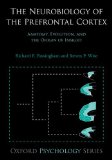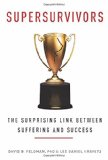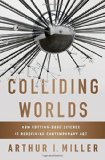July 1, 2014

The Neurobiology of the Prefrontal Cortex: Anatomy, Evolution, and the Origin of Insight (Oxford Psychology Series) by Richard E. Passingham and Steven P. Wise (Oxford University Press, 2014)
(kindle ed.), (amazon.co.uk), (UK kindle ed.)
Book description from the publisher:
The prefrontal cortex makes up almost a quarter of the human brain, and it expanded dramatically during primate evolution. The Neurobiology of the Prefrontal Cortex presents a new theory about its fundamental function. In this important new book, the authors argue that primate-specific parts of the prefrontal cortex evolved to reduce errors in foraging choices, so that particular ancestors of modern humans could overcome periodic food shortages. These developments laid the foundation for working out problems in our imagination, which resulted in the insights that allow humans to avoid errors entirely, at least at times.
In the book, the authors detail which parts of the prefrontal cortex evolved exclusively in primates, how its connections explain why the prefrontal cortex alone can perform its function, and why other parts of the brain cannot do what the prefrontal cortex does. Based on an analysis of its evolutionary history, the book uses evidence from lesion, imaging, and cell-recording experiments to argue that the primate prefrontal cortex generates goals from a current behavioural context and that it can do so on the basis of single events. As a result, the prefrontal cortex uses the attentive control of behaviour to augment an older general-purpose learning system, one that evolved very early in the history of animals. This older system learns slowly and cumulatively over many experiences based on reinforcement. The authors argue that a new learning system evolved in primates at a particular time and place in their history, that it did so to decrease the errors inherent in the older learning system, and that severe volatility of food resources provided the driving force for these developments.
Written by two leading brain scientists, The Neurobiology of the Prefrontal Cortex is an important contribution to our understanding of the evolution and functioning of the human brain.
Google Books preview:
See also: R. Passingham’s webpage
Comments (0)
- cognitive science,human evolution,new books
June 26, 2014

The Custom-Made Brain: Cerebral Plasticity, Regeneration, and Enhancement by Jean-Didier Vincent and Pierre-Marie Lledo (Columbia University Press, 2014)
(kindle ed.), (amazon.co.uk), (UK kindle ed.)
Book description from the publisher:
Two leading neuroscientists introduce the concepts of “cerebral plasticity” and the “regenerating brain,” describing what we know now about the processes through which the brain constantly reconstructs itself and the potential benefits this knowledge could have in addressing concerns for neurological, cognitive, and emotional health.
The authors begin with a survey of the fundamental scientific developments that led to our current understanding of the regenerative mind, elucidating the breakthrough neurobiological studies that paved the way for our present understanding of the brain’s plasticity and regenerative capabilities. They then discuss the application of these findings to such issues as depression, dyslexia, schizophrenia, and cognitive therapy, incorporating the latest technologies in neuroimaging, optogenetics, and nanotechnology. Their work shows the brain is anything but a static organ, ceasing to grow as human beings become adults. Rather, the brain is dynamic, evolving organically in relation to physical, cultural, historical, and affective stimuli, a plasticity that provides early hope to survivors of trauma and degenerative disorders.
Comments (0)
- cognitive science,new books
June 24, 2014

Supersurvivors: The Surprising Link Between Suffering and Success by David B. Feldman and Lee Daniel Kravetz (HarperWave, 2014)
(kindle ed.), (amazon.co.uk)
Book description from the publisher:
Starting where resiliency studies leave off, two psychologists explore the science of remarkable accomplishment in the wake of trauma, revealing the surprising principles that allow people to transform their lives and achieve extraordinary things.
Over four billion people worldwide will survive a trauma during their lives. Some will experience severe post-traumatic stress. Most will eventually recover and return to life as normal. But sometimes, survivors do more than bounce back. Sometimes they bounce forward.
These are the Supersurvivors—individuals who not only rebuild their lives, but also thrive and grow in ways never previously imagined. Beginning where resilience ends, David B. Feldman and Lee Daniel Kravetz look beyond the tenets of traditional psychology for a deeper understanding of the strength of the human spirit. What they have found flies in the face of conventional wisdom—that positive thinking may hinder more than help; that perceived support can be just as good as the real thing; and that realistic expectations may be a key to great success.
They introduce the humble but powerful notion of grounded hope as the foundation for overcoming trauma. The authors interviewed dozens of men and women whose stories serve as the counterpoint to the latest scientific research. Feldman and Kravetz then brilliantly weave these extraordinary narratives with new science, creating an emotionally compelling and thought-provoking look at what is possible in the face of human tragedy. Supersurvivors will reset our thinking about how we deal with challenges, no matter how big or small.
See also: Book website
Comments (0)
- new books,psychology
June 20, 2014

Quantum Models of Cognition and Decision by Jerome R. Busemeyer and Peter D. Bruza (Cambridge University Press, 2014)
(kindle ed.), (amazon.co.uk), (UK kindle ed.)
Book description from the publisher:
Much of our understanding of human thinking is based on probabilistic models. This innovative book by Jerome R. Busemeyer and Peter D. Bruza argues that, actually, the underlying mathematical structures from quantum theory provide a much better account of human thinking than traditional models. They introduce the foundations for modelling probabilistic-dynamic systems using two aspects of quantum theory. The first, ‘contextuality’, is a way to understand interference effects found with inferences and decisions under conditions of uncertainty. The second, ‘quantum entanglement’, allows cognitive phenomena to be modeled in non-reductionist ways. Employing these principles drawn from quantum theory allows us to view human cognition and decision in a totally new light. Introducing the basic principles in an easy-to-follow way, this book does not assume a physics background or a quantum brain and comes complete with a tutorial and fully worked-out applications in important areas of cognition and decision.
Google Books preview:
Comments (0)
- cognitive science,new books
June 15, 2014

Colliding Worlds: How Cutting-Edge Science Is Redefining Contemporary Art by Arthur I. Miller (W.W. Norton, 2014)
(kindle ed.), (amazon.co.uk), (UK kindle ed.)
Book description from the publisher:
A dazzling look at the artists working on the frontiers of science.
In recent decades, an exciting new art movement has emerged in which artists utilize and illuminate the latest advances in science. Some of their provocative creations—a live rabbit implanted with the fluorescent gene of a jellyfish, a gigantic glass-and-chrome sculpture of the Big Bang (pictured on the cover)—can be seen in traditional art museums and magazines, while others are being made by leading designers at Pixar, Google’s Creative Lab, and the MIT Media Lab. In Colliding Worlds, Arthur I. Miller takes readers on a wild journey to explore this new frontier.
Miller, the author of Einstein, Picasso and other celebrated books on science and creativity, traces the movement from its seeds a century ago—when Einstein’s theory of relativity helped shape the thinking of the Cubists—to its flowering today. Through interviews with innovative thinkers and artists across disciplines, Miller shows with verve and clarity how discoveries in biotechnology, cosmology, quantum physics, and beyond are animating the work of designers like Neri Oxman, musicians like David Toop, and the artists-in-residence at CERN’s Large Hadron Collider.
From NanoArt to Big Data, Miller reveals the extraordinary possibilities when art and science collide.
Google Books preview:
See also: Author’s website
Comments (0)
- culture,new books







